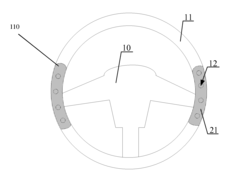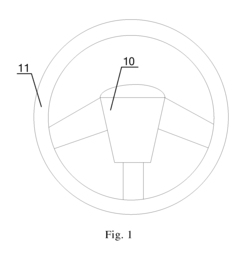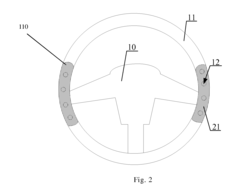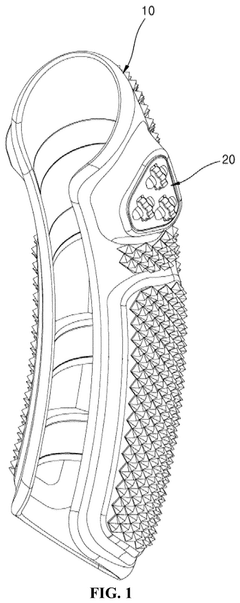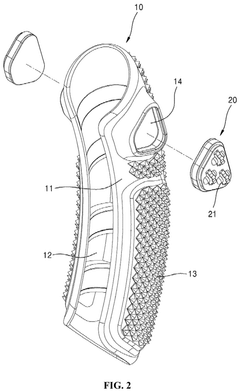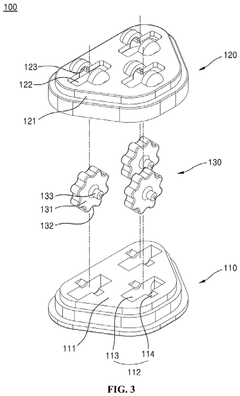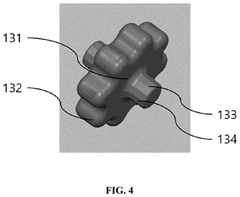Steering Wheel Applications: Addressing Driver Fatigue
JUL 18, 20259 MIN READ
Generate Your Research Report Instantly with AI Agent
Patsnap Eureka helps you evaluate technical feasibility & market potential.
Driver Fatigue Detection Background and Objectives
Driver fatigue has emerged as a critical safety concern in the automotive industry, contributing significantly to road accidents and fatalities worldwide. The development of steering wheel applications to address driver fatigue represents a crucial technological advancement aimed at enhancing road safety and reducing the risk of accidents caused by drowsy or fatigued drivers.
The evolution of driver fatigue detection technology can be traced back to the early 2000s when automotive manufacturers began incorporating basic drowsiness detection systems into high-end vehicles. These initial systems primarily relied on steering input patterns and vehicle trajectory to infer driver alertness. However, as technology progressed, more sophisticated methods emerged, incorporating physiological sensors, eye-tracking systems, and advanced machine learning algorithms.
The primary objective of steering wheel applications addressing driver fatigue is to create a robust, real-time monitoring system capable of accurately detecting signs of fatigue and alerting drivers before a potentially dangerous situation occurs. This technology aims to integrate seamlessly into the vehicle's existing infrastructure, providing a non-intrusive yet effective solution to combat driver fatigue.
Key technological goals in this field include developing highly sensitive and accurate sensors that can be embedded within the steering wheel to monitor various physiological parameters such as heart rate, skin conductance, and grip pressure. These sensors must be capable of functioning reliably in diverse environmental conditions and across a wide range of driver demographics.
Another critical objective is the development of advanced algorithms that can process and interpret the collected data in real-time, distinguishing between normal driving behaviors and those indicative of fatigue. This involves leveraging machine learning and artificial intelligence techniques to create adaptive systems that can learn from individual driver patterns and improve detection accuracy over time.
Furthermore, the technology aims to provide effective intervention strategies once fatigue is detected. This may include auditory and visual alerts, haptic feedback through the steering wheel, or integration with other vehicle systems to implement safety measures such as adaptive cruise control or lane-keeping assistance.
As the automotive industry moves towards autonomous driving, steering wheel applications for driver fatigue detection are also evolving to address the challenges of semi-autonomous vehicles. The technology must be capable of monitoring driver alertness during periods of manual control and ensuring a smooth transition between autonomous and manual driving modes based on the driver's state of alertness.
In conclusion, the background and objectives of driver fatigue detection through steering wheel applications reflect a critical area of technological development in automotive safety. By addressing the pervasive issue of driver fatigue, these innovations have the potential to significantly reduce road accidents and save lives, making them a key focus for both automotive manufacturers and safety regulators in the coming years.
The evolution of driver fatigue detection technology can be traced back to the early 2000s when automotive manufacturers began incorporating basic drowsiness detection systems into high-end vehicles. These initial systems primarily relied on steering input patterns and vehicle trajectory to infer driver alertness. However, as technology progressed, more sophisticated methods emerged, incorporating physiological sensors, eye-tracking systems, and advanced machine learning algorithms.
The primary objective of steering wheel applications addressing driver fatigue is to create a robust, real-time monitoring system capable of accurately detecting signs of fatigue and alerting drivers before a potentially dangerous situation occurs. This technology aims to integrate seamlessly into the vehicle's existing infrastructure, providing a non-intrusive yet effective solution to combat driver fatigue.
Key technological goals in this field include developing highly sensitive and accurate sensors that can be embedded within the steering wheel to monitor various physiological parameters such as heart rate, skin conductance, and grip pressure. These sensors must be capable of functioning reliably in diverse environmental conditions and across a wide range of driver demographics.
Another critical objective is the development of advanced algorithms that can process and interpret the collected data in real-time, distinguishing between normal driving behaviors and those indicative of fatigue. This involves leveraging machine learning and artificial intelligence techniques to create adaptive systems that can learn from individual driver patterns and improve detection accuracy over time.
Furthermore, the technology aims to provide effective intervention strategies once fatigue is detected. This may include auditory and visual alerts, haptic feedback through the steering wheel, or integration with other vehicle systems to implement safety measures such as adaptive cruise control or lane-keeping assistance.
As the automotive industry moves towards autonomous driving, steering wheel applications for driver fatigue detection are also evolving to address the challenges of semi-autonomous vehicles. The technology must be capable of monitoring driver alertness during periods of manual control and ensuring a smooth transition between autonomous and manual driving modes based on the driver's state of alertness.
In conclusion, the background and objectives of driver fatigue detection through steering wheel applications reflect a critical area of technological development in automotive safety. By addressing the pervasive issue of driver fatigue, these innovations have the potential to significantly reduce road accidents and save lives, making them a key focus for both automotive manufacturers and safety regulators in the coming years.
Market Analysis for Steering Wheel Safety Systems
The market for steering wheel safety systems addressing driver fatigue has experienced significant growth in recent years, driven by increasing awareness of road safety and advancements in automotive technology. This segment is part of the broader Advanced Driver Assistance Systems (ADAS) market, which is projected to reach substantial value in the coming years.
Driver fatigue is a major contributor to road accidents globally, accounting for a significant percentage of traffic-related fatalities. This has led to a surge in demand for innovative solutions that can detect and prevent driver drowsiness. Steering wheel applications have emerged as a key focus area for addressing this critical safety concern.
The market for steering wheel safety systems is characterized by a diverse range of products, including steering wheel sensors that monitor grip pressure and hand position, integrated cameras that track eye movement and facial expressions, and haptic feedback systems that alert drivers when signs of fatigue are detected. These technologies are increasingly being integrated into both luxury and mid-range vehicle models, expanding the potential market size.
Geographically, North America and Europe currently lead the market for steering wheel safety systems, owing to stringent safety regulations and higher consumer awareness. However, rapid growth is expected in Asia-Pacific markets, particularly in countries like China and India, where rising disposable incomes and increasing focus on vehicle safety are driving adoption.
The market is also influenced by evolving regulatory landscapes. Many countries are implementing or considering regulations that mandate the inclusion of driver fatigue detection systems in commercial vehicles, which is expected to boost market growth in the coming years.
Key market trends include the integration of artificial intelligence and machine learning algorithms to improve the accuracy of fatigue detection, as well as the development of non-intrusive monitoring systems that do not require direct contact with the driver. Additionally, there is a growing focus on combining steering wheel-based systems with other fatigue detection technologies, such as eye-tracking cameras and seat sensors, to create more comprehensive safety solutions.
The competitive landscape of the steering wheel safety systems market is characterized by a mix of established automotive suppliers and innovative technology startups. Major players are investing heavily in research and development to gain a competitive edge, while startups are bringing disruptive technologies to the market.
Looking ahead, the market for steering wheel applications addressing driver fatigue is poised for continued growth. Factors such as increasing vehicle electrification, the rise of autonomous driving technologies, and growing consumer demand for advanced safety features are expected to shape the future of this market segment.
Driver fatigue is a major contributor to road accidents globally, accounting for a significant percentage of traffic-related fatalities. This has led to a surge in demand for innovative solutions that can detect and prevent driver drowsiness. Steering wheel applications have emerged as a key focus area for addressing this critical safety concern.
The market for steering wheel safety systems is characterized by a diverse range of products, including steering wheel sensors that monitor grip pressure and hand position, integrated cameras that track eye movement and facial expressions, and haptic feedback systems that alert drivers when signs of fatigue are detected. These technologies are increasingly being integrated into both luxury and mid-range vehicle models, expanding the potential market size.
Geographically, North America and Europe currently lead the market for steering wheel safety systems, owing to stringent safety regulations and higher consumer awareness. However, rapid growth is expected in Asia-Pacific markets, particularly in countries like China and India, where rising disposable incomes and increasing focus on vehicle safety are driving adoption.
The market is also influenced by evolving regulatory landscapes. Many countries are implementing or considering regulations that mandate the inclusion of driver fatigue detection systems in commercial vehicles, which is expected to boost market growth in the coming years.
Key market trends include the integration of artificial intelligence and machine learning algorithms to improve the accuracy of fatigue detection, as well as the development of non-intrusive monitoring systems that do not require direct contact with the driver. Additionally, there is a growing focus on combining steering wheel-based systems with other fatigue detection technologies, such as eye-tracking cameras and seat sensors, to create more comprehensive safety solutions.
The competitive landscape of the steering wheel safety systems market is characterized by a mix of established automotive suppliers and innovative technology startups. Major players are investing heavily in research and development to gain a competitive edge, while startups are bringing disruptive technologies to the market.
Looking ahead, the market for steering wheel applications addressing driver fatigue is poised for continued growth. Factors such as increasing vehicle electrification, the rise of autonomous driving technologies, and growing consumer demand for advanced safety features are expected to shape the future of this market segment.
Current Challenges in Driver Fatigue Monitoring
Driver fatigue monitoring systems face several significant challenges in their current implementation and effectiveness. One of the primary obstacles is the accuracy and reliability of fatigue detection methods. While various technologies such as eye-tracking, facial recognition, and steering wheel sensors have been developed, they often struggle to consistently identify subtle signs of fatigue across diverse driver populations and environmental conditions.
The integration of these monitoring systems into existing vehicle architectures presents another hurdle. Manufacturers must balance the addition of new sensors and processing units with cost considerations and vehicle design constraints. This integration challenge extends to ensuring seamless communication between the fatigue monitoring system and other vehicle safety systems, such as lane departure warnings or automatic emergency braking.
Privacy concerns also pose a significant challenge in the widespread adoption of driver fatigue monitoring systems. The use of cameras and biometric sensors to track driver behavior raises questions about data collection, storage, and potential misuse. Striking a balance between effective monitoring and respecting driver privacy remains a complex issue for both manufacturers and regulators.
Another critical challenge lies in the development of appropriate intervention strategies once fatigue is detected. While alerting the driver is a common approach, the effectiveness of these alerts can diminish over time due to habituation. More advanced intervention methods, such as adaptive cruise control or semi-autonomous driving modes, are still in their infancy and require further refinement to ensure safety and driver acceptance.
The variability in individual fatigue manifestations further complicates the development of universally effective monitoring systems. Factors such as age, physical condition, medication use, and circadian rhythms can all influence how fatigue presents in different drivers. Creating a system that can accurately account for these individual differences while maintaining broad applicability remains a significant technical challenge.
Regulatory frameworks and standardization efforts for driver fatigue monitoring systems are still evolving. The lack of unified standards across different regions creates challenges for manufacturers in developing globally compliant systems. Additionally, the absence of clear guidelines on system performance benchmarks and testing protocols hinders the evaluation and comparison of different fatigue monitoring solutions.
Lastly, driver acceptance and trust in these systems represent a crucial challenge. Overcoming skepticism about the accuracy of fatigue detection and addressing concerns about system intrusiveness are essential for widespread adoption. Educating drivers about the benefits of fatigue monitoring systems and designing user-friendly interfaces that provide transparent feedback are ongoing challenges in the field.
The integration of these monitoring systems into existing vehicle architectures presents another hurdle. Manufacturers must balance the addition of new sensors and processing units with cost considerations and vehicle design constraints. This integration challenge extends to ensuring seamless communication between the fatigue monitoring system and other vehicle safety systems, such as lane departure warnings or automatic emergency braking.
Privacy concerns also pose a significant challenge in the widespread adoption of driver fatigue monitoring systems. The use of cameras and biometric sensors to track driver behavior raises questions about data collection, storage, and potential misuse. Striking a balance between effective monitoring and respecting driver privacy remains a complex issue for both manufacturers and regulators.
Another critical challenge lies in the development of appropriate intervention strategies once fatigue is detected. While alerting the driver is a common approach, the effectiveness of these alerts can diminish over time due to habituation. More advanced intervention methods, such as adaptive cruise control or semi-autonomous driving modes, are still in their infancy and require further refinement to ensure safety and driver acceptance.
The variability in individual fatigue manifestations further complicates the development of universally effective monitoring systems. Factors such as age, physical condition, medication use, and circadian rhythms can all influence how fatigue presents in different drivers. Creating a system that can accurately account for these individual differences while maintaining broad applicability remains a significant technical challenge.
Regulatory frameworks and standardization efforts for driver fatigue monitoring systems are still evolving. The lack of unified standards across different regions creates challenges for manufacturers in developing globally compliant systems. Additionally, the absence of clear guidelines on system performance benchmarks and testing protocols hinders the evaluation and comparison of different fatigue monitoring solutions.
Lastly, driver acceptance and trust in these systems represent a crucial challenge. Overcoming skepticism about the accuracy of fatigue detection and addressing concerns about system intrusiveness are essential for widespread adoption. Educating drivers about the benefits of fatigue monitoring systems and designing user-friendly interfaces that provide transparent feedback are ongoing challenges in the field.
Existing Driver Fatigue Detection Solutions
01 Steering wheel-based driver fatigue detection systems
These systems use sensors integrated into the steering wheel to monitor driver behavior and physiological signals. They can detect changes in grip pressure, steering patterns, and even biometric data like heart rate or skin conductivity to assess driver fatigue levels. When signs of fatigue are detected, the system can alert the driver or trigger other safety measures.- Steering wheel-based driver fatigue detection systems: These systems use sensors integrated into the steering wheel to monitor driver behavior and physiological signals. They can detect changes in grip pressure, steering patterns, and even biometric data like heart rate or skin conductivity to assess driver fatigue levels. When signs of fatigue are detected, the system can alert the driver or trigger other safety measures.
- Computer vision and AI-based driver monitoring: Advanced camera systems and artificial intelligence algorithms are used to analyze the driver's facial expressions, eye movements, and head position. These systems can detect signs of drowsiness or distraction, such as frequent blinking, nodding, or looking away from the road. When fatigue is detected, the system can issue warnings or activate driver assistance features.
- Haptic feedback and steering wheel vibration alerts: This technology involves incorporating vibration motors or other haptic feedback mechanisms into the steering wheel. When driver fatigue is detected through various sensors, the system can provide tactile alerts to the driver by vibrating the steering wheel. This serves as a non-intrusive way to alert the driver and promote increased alertness.
- Integrated driver assistance and fatigue management systems: These comprehensive systems combine multiple technologies to monitor driver fatigue and provide assistance. They may include steering wheel sensors, camera-based monitoring, and integration with other vehicle systems like lane departure warnings or adaptive cruise control. The system can adjust vehicle behavior or provide targeted alerts based on detected fatigue levels.
- Predictive fatigue analysis and prevention: Advanced systems that use machine learning and data analysis to predict driver fatigue before it becomes critical. These systems may consider factors such as time of day, duration of driving, past behavior patterns, and even external factors like weather conditions. They can provide early warnings or suggest preventive measures like rest stops to mitigate fatigue risks.
02 Computer vision and AI-based driver monitoring
Advanced camera systems and artificial intelligence algorithms are used to analyze the driver's facial expressions, eye movements, and head position. These systems can detect signs of drowsiness or distraction, such as frequent blinking, nodding off, or looking away from the road. When fatigue is detected, the system can issue warnings or activate driver assistance features.Expand Specific Solutions03 Haptic feedback and steering wheel vibration alerts
This technology involves incorporating vibration motors or other haptic feedback mechanisms into the steering wheel. When driver fatigue is detected through various means, the system can provide tactile alerts to the driver by vibrating the steering wheel. This serves as a non-intrusive way to grab the driver's attention and prompt them to take a break or refocus on driving.Expand Specific Solutions04 Integrated driver assistance and fatigue management systems
These comprehensive systems combine multiple technologies to monitor driver fatigue and provide assistance. They may incorporate steering wheel sensors, camera-based monitoring, and vehicle performance data. When fatigue is detected, the system can activate various safety features such as lane keeping assist, adaptive cruise control, or even initiate a controlled stop if necessary.Expand Specific Solutions05 Predictive fatigue analysis and prevention
This approach uses machine learning algorithms and historical data to predict when a driver is likely to become fatigued. By analyzing factors such as time of day, duration of driving, and past behavior patterns, the system can proactively suggest breaks or alternate routes to prevent fatigue before it becomes a safety issue. It may also adjust vehicle systems to help keep the driver alert.Expand Specific Solutions
Key Players in Automotive Safety and Sensor Industry
The steering wheel applications addressing driver fatigue represent a growing market within the automotive safety sector. This technology is in its early to mid-stage development, with increasing adoption as vehicle manufacturers prioritize driver safety. The market size is expanding, driven by stricter safety regulations and consumer demand for advanced driver assistance systems. Technologically, solutions range from basic monitoring systems to more sophisticated AI-driven interventions. Companies like Toyota, Mercedes-Benz, and Ford are at the forefront, investing heavily in R&D. Emerging players such as ZF Automotive Safety and Continental Automotive are also making significant strides, while Tesla and other EV manufacturers are integrating these technologies into their autonomous driving systems.
Mercedes-Benz Group AG
Technical Solution: Mercedes-Benz has developed an advanced steering wheel system called ATTENTION ASSIST to address driver fatigue. This system uses a sensitive sensor to monitor steering behavior, which can detect typical signs of drowsiness. When fatigue is detected, the system alerts the driver with visual and audible warnings. Additionally, Mercedes-Benz has integrated a hands-off detection feature that uses capacitive sensing technology to ensure the driver maintains contact with the steering wheel[1][3]. The company is also exploring the use of biometric sensors in steering wheels to monitor vital signs such as heart rate and skin conductance for more accurate fatigue detection[2].
Strengths: Comprehensive fatigue detection system, integration with other vehicle safety features, and continuous innovation in biometric sensing. Weaknesses: Potential for false alarms and reliance on driver responsiveness to warnings.
Ford Global Technologies LLC
Technical Solution: Ford has developed a Driver Alert system that uses a forward-facing camera and on-board sensors to detect if a driver is showing signs of fatigue. The system monitors vehicle movement, particularly lane positioning, and calculates a "driver alert" score. If the score falls below a certain threshold, visual and audio warnings are triggered. Ford is also working on integrating wearable devices with the steering wheel to monitor biometric data for more accurate fatigue detection[4]. Additionally, Ford's Lane-Keeping System works in conjunction with the Driver Alert system, providing steering torque to guide the vehicle back into the lane if unintentional drifting is detected[5].
Strengths: Multi-faceted approach combining visual monitoring and vehicle dynamics, integration with lane-keeping assistance. Weaknesses: Potential privacy concerns with biometric data collection, system effectiveness may vary in different driving conditions.
Core Innovations in Steering Wheel Sensor Technology
Vehicle steering wheel
PatentActiveUS20160338632A1
Innovation
- A vehicle steering wheel equipped with oximeters in the handheld areas connected to a control device and alarm system, which monitors oxyhemoglobin saturation levels to detect fatigue and triggers an alarm if the driver is fatigued, prompting the driver to take rest breaks.
Steering wheel grip assembly for automobiles
PatentPendingUS20250128753A1
Innovation
- A steering wheel grip assembly that includes a grip body with body protrusions for acupressure and a fidget mounted on the grip body, allowing users to operate the fidget with their fingers while driving, thereby preventing drowsiness and improving concentration.
Regulatory Framework for In-Vehicle Safety Systems
The regulatory framework for in-vehicle safety systems addressing driver fatigue through steering wheel applications is a complex and evolving landscape. Governments and regulatory bodies worldwide recognize the critical importance of mitigating driver fatigue to enhance road safety. In the United States, the National Highway Traffic Safety Administration (NHTSA) has been at the forefront of developing guidelines and standards for advanced driver assistance systems (ADAS), including those that monitor driver alertness.
The European Union has implemented stringent regulations through the European New Car Assessment Programme (Euro NCAP), which now includes driver monitoring systems as part of its safety rating criteria. These regulations mandate that vehicles be equipped with technologies capable of detecting driver drowsiness and distraction, with steering wheel-based systems being a key component of this approach.
In Japan, the Ministry of Land, Infrastructure, Transport and Tourism (MLIT) has established guidelines for the implementation of driver monitoring systems, emphasizing the need for non-intrusive technologies that can effectively detect signs of fatigue. The Japanese regulatory framework encourages the integration of steering wheel sensors as part of a comprehensive driver monitoring solution.
The regulatory landscape also addresses data privacy concerns associated with driver monitoring systems. For instance, the General Data Protection Regulation (GDPR) in the European Union imposes strict requirements on the collection and processing of personal data, including biometric information that may be gathered by steering wheel sensors. Manufacturers must ensure compliance with these data protection regulations when developing and implementing driver fatigue detection systems.
Standardization efforts are underway to establish common protocols for driver monitoring systems. The International Organization for Standardization (ISO) is developing standards such as ISO 39860, which aims to provide guidelines for the design and evaluation of driver monitoring systems, including those integrated into steering wheels.
As the technology advances, regulatory bodies are also considering the potential for these systems to become mandatory safety features in new vehicles. The European Commission, for example, has proposed regulations that would require all new cars to be equipped with advanced safety systems, including driver drowsiness and attention warning systems, by 2022.
The regulatory framework also extends to the testing and certification of these systems. Regulatory bodies are developing standardized test procedures to evaluate the effectiveness of driver fatigue detection technologies, ensuring that they meet minimum performance criteria before being approved for use in vehicles.
The European Union has implemented stringent regulations through the European New Car Assessment Programme (Euro NCAP), which now includes driver monitoring systems as part of its safety rating criteria. These regulations mandate that vehicles be equipped with technologies capable of detecting driver drowsiness and distraction, with steering wheel-based systems being a key component of this approach.
In Japan, the Ministry of Land, Infrastructure, Transport and Tourism (MLIT) has established guidelines for the implementation of driver monitoring systems, emphasizing the need for non-intrusive technologies that can effectively detect signs of fatigue. The Japanese regulatory framework encourages the integration of steering wheel sensors as part of a comprehensive driver monitoring solution.
The regulatory landscape also addresses data privacy concerns associated with driver monitoring systems. For instance, the General Data Protection Regulation (GDPR) in the European Union imposes strict requirements on the collection and processing of personal data, including biometric information that may be gathered by steering wheel sensors. Manufacturers must ensure compliance with these data protection regulations when developing and implementing driver fatigue detection systems.
Standardization efforts are underway to establish common protocols for driver monitoring systems. The International Organization for Standardization (ISO) is developing standards such as ISO 39860, which aims to provide guidelines for the design and evaluation of driver monitoring systems, including those integrated into steering wheels.
As the technology advances, regulatory bodies are also considering the potential for these systems to become mandatory safety features in new vehicles. The European Commission, for example, has proposed regulations that would require all new cars to be equipped with advanced safety systems, including driver drowsiness and attention warning systems, by 2022.
The regulatory framework also extends to the testing and certification of these systems. Regulatory bodies are developing standardized test procedures to evaluate the effectiveness of driver fatigue detection technologies, ensuring that they meet minimum performance criteria before being approved for use in vehicles.
Human Factors in Steering Wheel Interface Design
Human factors play a crucial role in the design of steering wheel interfaces, especially when addressing driver fatigue. The ergonomic considerations in steering wheel design are paramount to ensure driver comfort, safety, and optimal performance during extended periods of driving.
One of the primary concerns in steering wheel interface design is the placement and accessibility of controls. As drivers spend a significant amount of time with their hands on the wheel, integrating essential functions into the steering wheel itself can reduce fatigue by minimizing the need for drivers to remove their hands from the wheel. This includes incorporating buttons for audio controls, cruise control, and voice command activation within easy reach of the driver's thumbs.
The shape and size of the steering wheel are also critical factors in reducing driver fatigue. A wheel that is too large or too small can lead to increased muscle strain and discomfort over time. Designers must consider the average anthropometric measurements of the target user population to determine the optimal wheel diameter and grip circumference. Additionally, the cross-section of the wheel rim should be designed to provide a comfortable and secure grip, often featuring a slightly flattened profile on the sides.
Tactile feedback is another essential aspect of steering wheel interface design. The use of different textures and materials can help drivers maintain a firm grip without excessive force, reducing hand and arm fatigue. Some advanced designs incorporate haptic feedback systems that provide subtle vibrations or resistance changes to alert drivers of potential hazards or lane departures, enhancing safety without causing additional fatigue.
The weight and resistance of the steering system also impact driver fatigue. While power steering has become standard in most vehicles, the level of assistance must be carefully calibrated. Too little assistance can lead to increased physical exertion, while too much can reduce road feel and driver engagement. Adaptive steering systems that adjust resistance based on vehicle speed and driving conditions can help optimize the balance between ease of use and driver control.
Temperature management is an often-overlooked aspect of steering wheel design that can significantly affect driver comfort and fatigue levels. Heated steering wheels have become popular in colder climates, but there is also potential for cooling systems in hotter environments. These temperature control features can help maintain optimal grip and reduce discomfort during extreme weather conditions.
Lastly, the visual design of the steering wheel and its integrated displays must be considered from a human factors perspective. Any information displayed on or around the steering wheel should be easily readable without causing eye strain or requiring the driver to look away from the road for extended periods. The use of heads-up displays or augmented reality systems integrated with the steering wheel interface can provide critical information while minimizing visual distraction and associated fatigue.
One of the primary concerns in steering wheel interface design is the placement and accessibility of controls. As drivers spend a significant amount of time with their hands on the wheel, integrating essential functions into the steering wheel itself can reduce fatigue by minimizing the need for drivers to remove their hands from the wheel. This includes incorporating buttons for audio controls, cruise control, and voice command activation within easy reach of the driver's thumbs.
The shape and size of the steering wheel are also critical factors in reducing driver fatigue. A wheel that is too large or too small can lead to increased muscle strain and discomfort over time. Designers must consider the average anthropometric measurements of the target user population to determine the optimal wheel diameter and grip circumference. Additionally, the cross-section of the wheel rim should be designed to provide a comfortable and secure grip, often featuring a slightly flattened profile on the sides.
Tactile feedback is another essential aspect of steering wheel interface design. The use of different textures and materials can help drivers maintain a firm grip without excessive force, reducing hand and arm fatigue. Some advanced designs incorporate haptic feedback systems that provide subtle vibrations or resistance changes to alert drivers of potential hazards or lane departures, enhancing safety without causing additional fatigue.
The weight and resistance of the steering system also impact driver fatigue. While power steering has become standard in most vehicles, the level of assistance must be carefully calibrated. Too little assistance can lead to increased physical exertion, while too much can reduce road feel and driver engagement. Adaptive steering systems that adjust resistance based on vehicle speed and driving conditions can help optimize the balance between ease of use and driver control.
Temperature management is an often-overlooked aspect of steering wheel design that can significantly affect driver comfort and fatigue levels. Heated steering wheels have become popular in colder climates, but there is also potential for cooling systems in hotter environments. These temperature control features can help maintain optimal grip and reduce discomfort during extreme weather conditions.
Lastly, the visual design of the steering wheel and its integrated displays must be considered from a human factors perspective. Any information displayed on or around the steering wheel should be easily readable without causing eye strain or requiring the driver to look away from the road for extended periods. The use of heads-up displays or augmented reality systems integrated with the steering wheel interface can provide critical information while minimizing visual distraction and associated fatigue.
Unlock deeper insights with Patsnap Eureka Quick Research — get a full tech report to explore trends and direct your research. Try now!
Generate Your Research Report Instantly with AI Agent
Supercharge your innovation with Patsnap Eureka AI Agent Platform!
